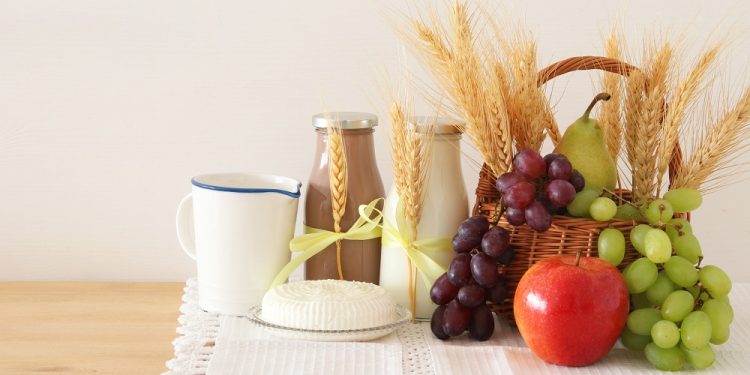
Shavuot
Shavuot is a Jewish holiday known in English as the Feast of Weeks. This harvest festival falls on the sixth day of the Hebrew month of Sivan, placing it sometime between May 15th and June 14th on the Gregorian calendar.
The holiday marks the wheat harvest in the land of Israel, as recounted by the Bible, and according to Rabbinic Judaism, it also commemorates the anniversary of God giving the Torah to the Israelites at Mount Sinai. Since it is one of the Three Pilgrimage Festivals, as ordained by the Bible, the holiday is generally celebrated in Israel for one day and over a two-day period in the Diaspora.
The Significance of This Holiday
Although the granting of the Torah to the Israelites is not explicitly stated to have been done on this day, oral tradition considers it to be its main significance. What is connected to this holiday, however, is the harvest of the wheat in the Land of Israel. In ancient Israel, the harvest of the grain crops lasted approximately seven weeks and was considered a season of happiness.
It started with the barley harvest during Passover and ended with the wheat harvest on Shavuot. This made Shavuot the conclusion of the festival of the grain harvest. When the Temple in Jerusalem existed, this would be a time when two loaves of bread were made on this day.
In the Bible, Shavuot is mentioned as the Festival of Weeks and the Festival of Reaping. It is also known as the Day of the First Fruits. In the Talmud, Shavuot is known as Atzeret, which means “refraining,” and this is a reference to the prohibition against work on this day.
The History of Shavuot in Antiquity
In ancient Israel, Shavuot was the first day on which people could bring the Bikkurim for the Ceremony of First Fruits to the Temple in Jerusalem. The Bikkurim consisted of the Seven Species of agricultural products that were praised in Israel—two of which were grains and five of which were fruits.
These were barley, wheat, figs, grapes, pomegranates, olives, and dates. During this time, Jewish farmers would identify the first ripening fruits from each of these species in their fields and tie a reed around them. When it was time to harvest them, they would cut the ones that were marked and place them in special woven baskets. These baskets would then be loaded onto oxen and added to a procession to Jerusalem.
When each farmer arrived at the Temple in Jerusalem, they would present their Bikkurim to a Kohen (priest), and the text found in Deuteronomy Chapter 26:1–10 is then recited. This text retells the history of the Jewish people as they went into exile in Ancient Egypt and were enslaved and oppressed. The Bikkurim Ceremony gives thanks to God not only for the first fruits found in the fields but also for His guidance throughout all of Jewish history.
Modern Shavuot Religious Practices & Observances
Nowadays, Shavuot is the only holiday ordained by the Bible that has no specific laws attached to it other than the festival requirements of abstaining from creative work. Rabbinical observances of this holiday include reciting additional prayers, making Kiddush, and partaking of meals.
This holiday does have a number of different customs that are observed. These may include the reading of the Akdamut; the consumption of dairy products such as cheese and milk; the decoration of synagogues and homes with greenery; all-night Torah studies; and reading from the Book of Ruth.
The Akdamut is a liturgical poem that enthusiastically praises God, Israel, and the Torah. It is read publicly in the synagogue before the morning reading of the Torah on the first day of this holiday. This text was written in 1096 after the First Crusade by Rabbi Meir of Worms.
His son was murdered during the crusade, and he was forced to defend the Torah and his Jewish faith in a debate with local priests. He was able to successfully convey the certainty of God’s power, the excellence of the Torah, and his love for the Jewish people. He wrote the 90-line poem in Aramaic that stressed these themes. This poem is not read by Sephardi Jews, who instead sing a poem called Azharot.
During Shavuot, dairy foods are usually consumed, except among Yemenite Jews who do not eat dairy on this day. Among Syrian Jews, a cheese-filled pancake known as atayef is usually consumed. Among Iraqi Jews, a buttered and sugared dough known as Kahi is eaten. Among Ashkenazi Jews, foods such as cheese blintzes, cheesecake, and cheese kreplach are usually eaten. On Shavuot, there is usually a day meal that involves dairy and a night meal that involves meat.
The Book of Ruth is read on Shavuot because a descendant of Ruth, King David, was born and died on Shavuot. It is also read because the events in this book occur during harvest time, and the themes of this book align quite well with the themes of Shavuot.
According to tradition, Mount Sinai blossomed with flowers in anticipation of the giving of the Torah on its summit, and that is why decorating homes and synagogues is a tradition observed to this day. Jewish families decorate synagogues and homes with flowers, plants, and leafy branches.
Staying up to study the Torah all night is linked to a Midrash that tells the story of what happened the night before the Israelites received the Torah. On that night, they retired early to ensure that they were well-rested for the next day but ended up oversleeping. Moses had to wake them up because God was waiting on the mountaintop. To rectify what they believe is a flaw in their national character, some Jews stay up all night to learn the Torah.
Modern Secular Observances of Shavuot
In secular agricultural communities in Israel, this holiday is observed as a harvest festival. During this festival, not only are agricultural products and machines presented to the community, but also babies born during the preceding year are introduced to the community.
During the 19th century, Orthodox synagogues in Australia and Great Britain would hold confirmation ceremonies for 12-year-old girls on this holiday. This was a precursor to the modern Bat Mitzvah. Nowadays, Reform synagogues in North America hold confirmation ceremonies on Shavuot for students ages 16 through 18 years of age.
Interesting Facts About Shavuot
Shavuot is an interesting holiday that is not fully understood by people outside of the Jewish faith. That is why we have decided to list some interesting facts about it. We hope the following section illuminates Shavuot a little more for people who may not be familiar with it.
Shavuot is the Jewish Paper-Cutting Holiday
Many Jews on this day use paper cuts for decorating their homes because some rabbis are uncomfortable with decorating synagogues and homes with greenery and flowers, as they felt it too closely resembled Christian traditions, so paper cuts were used instead.
Shavuot Is the Holiday of Water
In many cities in Israel, large crowds of people engage in water fights with water guns on this holiday. Other people head out to the country to commune with lakes, streams, and rivers. No one is sure where this tradition started, but some people believe that it comes from North African Jewish communities that associate water with the Torah. Or, it might just be a way to cool off during a very hot season.
There Are a Number of Theories as to Why Dairy Is Consumed
The consumption of fish and meat are signs of celebration in Jewish tradition, which is why people eat chicken or beef on some Jewish holidays. So why is dairy consumed on Shavuot?
There are a lot of theories as to why dairy foods like blintzes and cheesecake are eaten on this day, but one of the most common theories is that it had to do with the dietary laws given to the Israelites. When the kosher laws were passed down to the Israelites and they discovered that their meat was no longer kosher, they ate dairy foods instead.
Shavuot Has No Fixed Date
According to what is written in the Bible, this holiday is observed seven weeks after the sickle is first put to the standing grain. This is usually counted starting with the second day of Passover.
In ancient times, the new month was established on the basis of witness reports. This means that this holiday could fall on either the 5th or the 6th day of the month of Sivan. In modern times, however, the day is observed on the 6th day of the Hebrew month of Sivan.
It’s One of the Least Observed Jewish Holidays
The Passover Seder is one of the most widely observed Jewish rituals, so when Shavuot is observed seven weeks afterward, it is not surprising it is not as widely observed. Some people feel this is because Shavuot is missing dramatic rituals such as can be found in Sukkot, Rosh Hashanah, or Passover.
Ladino Speakers Recite the Liturgical Poem Le Ketubah de la Ley
Many people liken the relationship between the Jewish people and God to marriage. The Talmud refers to Shavuot as the wedding day of the Jewish people and God. As a result, some Sephardic communities created liturgy that described this holiday as a symbolic engagement between the Jewish people and God. This metaphor is taken even further by Ladino-speaking Jews who recite the liturgical poem Le Ketubah de la Ley—a marriage contract.








